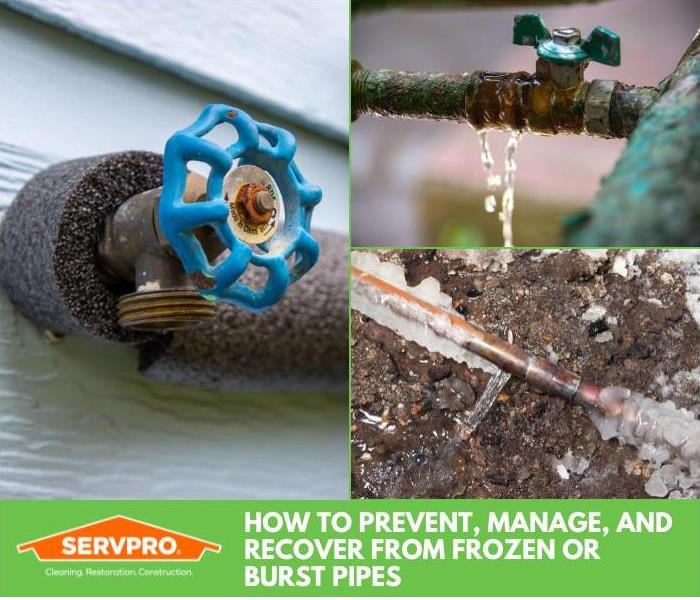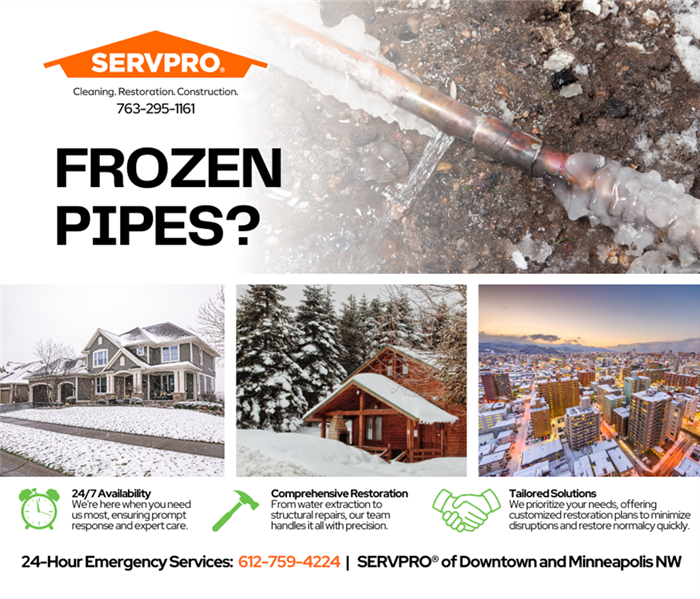Recent Water Damage Posts
Winter Pipe Care: How to Prevent, Manage, and Recover from Frozen or Burst Pipes
1/13/2025 (Permalink)
 Winter weather doesn’t have to mean disaster—prevent frozen pipes, act quickly, and minimize damage if one bursts.
Winter weather doesn’t have to mean disaster—prevent frozen pipes, act quickly, and minimize damage if one bursts.
SERVPRO® Winter Pipe Care: How to Prevent, Manage, and Recover from Frozen or Burst Pipes
As temperatures drop, the risk of frozen and burst pipes increases. Frozen pipes can cause significant damage to your property, but with the right preparation and quick action, you can prevent costly repairs and disruptions. Here are essential tips to help you stay ahead of winter’s challenges.
Part 1: How to Keep Pipes From Freezing
Preventing frozen pipes starts with proactive measures. Here’s how you can keep your pipes flowing even during the coldest days:
- Keep your thermostat consistent: Set your thermostat to the same temperature day and night to avoid drastic temperature drops that can cause pipes to freeze.
- Let faucets drip: During extreme cold, allow faucets to drip slightly to keep water moving, which helps prevent freezing.
- Open cabinet doors: If you have pipes under sinks, open the cabinet doors to let warm air circulate around them.
- Insulate exposed pipes: Protect pipes in unheated areas like basements, garages, or crawl spaces with insulation to reduce the risk of freezing.
By staying proactive, you can protect your home or business from the costly damage frozen pipes can cause.
Part 2: What to Do If Your Pipes Freeze
If your pipes do freeze, don’t panic. Follow these steps to address the problem quickly:
- Turn on the faucet: Open the faucet connected to the frozen pipe. This helps relieve pressure and allows water to flow once the ice melts.
- Apply heat: Use a heating pad, hair dryer, or warm towels to thaw the frozen section. Start near the faucet and work your way down the pipe. Never use an open flame!
- Monitor progress: Be patient as you thaw the pipe. If you can’t locate the frozen area or restore water flow, call a professional plumber for assistance.
Taking swift action can help minimize the risk of the pipe bursting and causing additional damage.
Part 3: What to Do If a Pipe Bursts
A burst pipe is a plumbing emergency that requires immediate attention. Here’s what to do:
- Shut off the water supply: Turn off your home’s main water supply to stop further flooding.
- Turn off electricity: If water is near electrical systems or outlets, turn off the power to avoid electrical hazards.
- Call a plumber: Contact a licensed plumber to repair the damaged pipe.
- Contact SERVPRO of Downtown Minneapolis/Team Hickman: Burst pipes can leave behind significant water damage. Our team is available 24/7 to provide professional water damage cleanup and restoration.
Winter weather doesn’t have to lead to disaster. By taking preventive measures, acting quickly when pipes freeze, and knowing what to do if a pipe bursts, you can protect your property and minimize damage. If you need assistance with water damage or restoration, SERVPRO of Downtown Minneapolis/Team Hickman is here to help anytime, day or night. Give us a call today!
Snow, Rain, and Ice Damage
3/25/2024 (Permalink)
 Snow, ice, and rain can wreak havoc on your home or business!
Snow, ice, and rain can wreak havoc on your home or business!
With significant snowfall and rain expected in the coming days, it's essential to remain alert to protect your property. Snow and ice pose various threats to both homes and businesses:
1?? Roof Damage: Heavy snow can strain roofs, causing collapse or structural issues. Ice dams may lead to leaks.
2?? Frozen Pipes: Low temperatures can freeze and burst water pipes, causing flooding.
3?? Gutter Damage: Ice buildup in gutters can block drainage, causing leaks and fascia damage.
4?? Foundation Cracks: Freeze-thaw cycles can crack foundations.
5?? Siding Damage: Ice and snow can lead to cracks and moisture issues.
6?? Tree and Landscaping Damage: Heavy snow can cause tree limbs to damage property.
7?? Window and Door Damage: Ice buildup can damage seals, leading to drafts, leaks, and misalignment.
Don't forget: SERVPRO of Downtown and Minneapolis NW/Team Hickman is here round the clock for any winter emergencies. Reach out to us anytime at ?? 763-295-1161.
5 Tips for Water Mitigation - Commercial
1/25/2024 (Permalink)
Water has the potential to wreak havoc on a commercial building within a short timeframe. To mitigate the damage effectively and prevent secondary issues like mold growth, it is crucial to promptly address standing water and residual moisture.
Consider the following five essential tips for water mitigation and cleanup:
Remove Standing Water: The initial step in tackling water damage involves eliminating standing water using portable pumps or a wet vac. Professionals specializing in water damage mitigation can swiftly and comprehensively extract water while offering valuable cleaning tips for both building materials and contents.
Enhance Airflow: Restoration experts may recommend deploying ventilation equipment such as air movers or fans to facilitate drying. Ventilation proves particularly effective when addressing clean water introduced by a pipe burst. However, caution is advised in areas exposed to contaminated water for an extended period, as circulating air may spread spores.
Explore Heated Drying Methods: In certain situations, the use of heat can expedite the drying process. The level of contamination, duration of damage, and the materials affected play crucial roles in determining the most suitable drying methods. Restoration professionals can provide tailored advice based on the specific circumstances.
Control Humidity Levels: humidity reduction discourages fungal growth.
Wait for Complete Drying: Commencing rebuilding or restoration should be postponed until the water-damaged portion of the structure has been thoroughly cleaned, disinfected, and dried. This includes the replacement of any contaminated building materials that were removed during the mitigation process.
If your home or business has water damage, contact the pros at SERVPRO® of Downtown and Minneapolis Northwest as soon as possible! Our crews are available 24-hours a day by calling 612-759-4224.
5 Tips to Prevent Frozen Pipes
1/23/2024 (Permalink)
 Home, cabin, or commercial property - SERVPRO® of Downtown and Minneapolis NW is available 24/7 for your water restoration needs.
Home, cabin, or commercial property - SERVPRO® of Downtown and Minneapolis NW is available 24/7 for your water restoration needs.
Minnesota winters can be harsh, and when faced with a cold snap, the risk of burst pipes in our homes and businesses become a concern. Internal pipes are susceptible to bursting when the water within them freezes and expands, exerting excessive pressure.
To prevent this scenario, consider these five tips for safeguarding your home:
Enhance Air Circulation: Pipes within areas like kitchens and bathrooms, often situated on exterior walls behind cabinet doors, can benefit from the warmth inside. Open these doors to allow warm air in.
Insulate At-risk Pipes: Use insulation or heat tape to keep vulnerable pipes warm and protected.
Daily Faucet Running: Ensure all faucets are run daily, especially those with cold pipes. Continuous water flow prevents freezing.
Maintain Consistent Heating: While a lower heating bill is tempting, it's crucial to keep your home consistently heated above at least 55 degrees during cold spells. Avoid the potential damage and expenses associated with burst pipes.
Seal unused spaces: In areas like attics and crawl spaces, add insulation if possible. If not, seal off gaps under doors, windows, and other cracks to minimize heat loss.
In case of a pipe burst, SERVPRO® of Downtown and Minneapolis NW is available 24/7 to provide assistance, give us a call at 612-759-4224. Additionally, contact your insurance agent promptly to assess coverage for any resulting damage. Stay safe and warm!
SERVPRO® of Downtown and Minneapolis NW provides services to the following cities: Northwest Minneapolis, Downtown Minneapolis, Hawthorne neighborhood, Columbia Heights, Brooklyn Center, New Hope, Fridley, Spring Lake Park, Crystal, Robbinsdale, and surrounding area.
 Winter weather doesn’t have to mean disaster—prevent frozen pipes, act quickly, and minimize damage if one bursts.
Winter weather doesn’t have to mean disaster—prevent frozen pipes, act quickly, and minimize damage if one bursts.





 24/7 Emergency Service
24/7 Emergency Service

